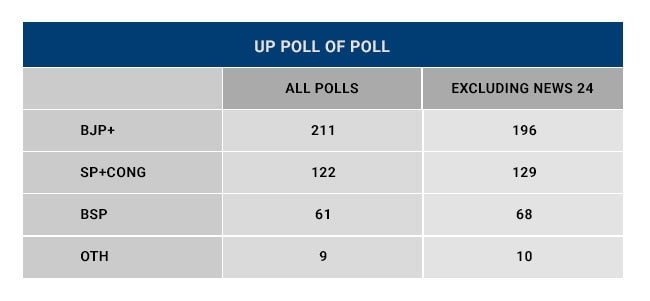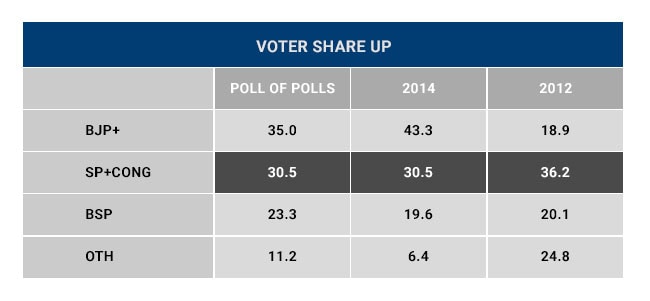While this euphoria over the forecast of a BJP sweep, except in Punjab, may have those on Twitter celebrating, the political class itself remains much more circumspect. Even BJP leaders are not popping the champagne, as memories of Bihar's exit polls being completely wrong still linger in their minds. And if you look at the gamut of predictions for tomorrow, it is obvious that some, many, or may be all pollsters could be wrong.
Take UP, the state steals the limelight in these elections, because of its political weight. If you plot the predictions of the BJP vote and seats (see chart below) you will find that most of them have coalesced around 33% vote share and anything between 165-200 seats.

Some polling also shows that Muslim consolidation around the SP-Congress could possibly have triggered a Hindu consolidation around the BJP especially in the later phases of voting. In 2014, the BJP swept eastern UP, so such a scenario remains possible. If you don't buy the consolidation of votes and so exclude the News24 projections as an outlier, then the poll of polls changes, though it continues to show the BJP well ahead but just under a majority:



The exit polls in Punjab also reflect two other trends: the collapse of the Akalis and with them, the BJP, is reflected in all the polls; and the continued growth of AAP shows that 2014 was not a flash in the pan and they are emerging as a major national player.

In less than 12 hours, the actual results will start coming in, and many exit poll predictions will be proved wrong. Wrong, because polling isn't a science: it is a projection from a sample. The problem is that in homogenous countries, it is easier to project from small samples, but in places like UP, where more than hundreds of sub-castes exist and caste-wise voting is often the case, pollsters face the enormously difficult job of choosing their samples correctly. Now if you launch such polls across seven diverse phases, the chances of being wrong increase.
The Trump victory in the US elections highlighted the fact that small samples cannot capture the voting variations by region and other demographics. The US election also saw a lot of people who did not admit that they were voting for Trump. Similar trends have affected Indian pollsters for many years - so take the polls with a pinch of salt. They are indicators of a pattern, or a trend, and the "trend" seems to be heading BJP's way, but whether these trends convert to a sweep is a more difficult call.
(Ishwari Bajpai is Senior Advisor at NDTV)
Disclaimer: The opinions expressed within this article are the personal opinions of the author. The facts and opinions appearing in the article do not reflect the views of NDTV and NDTV does not assume any responsibility or liability for the same.


